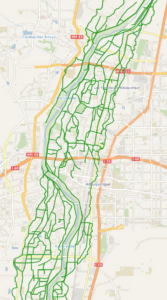
MRGCD ditches and drains, green
One of the conceptual riddles Bob Berrens and I are working through in the new book we’re pursuing on New Mexico’s Middle Rio Grande, and the work surrounding it, is the ecosystem goods and services across our valley floor provided by the Middle Rio Grande Conservancy District’s web of irrigation ditches.
Where once we had a river meandering across a broad flood plain, we now have a river tightly confined between levees, replaced by said web of irrigation ditches.
Anecdotally, I see a couple of things in my wanders of the valley floor.
The most obvious is the neighborhood amenity value. People love these ditches! During the pandemic’s peak, ditch walking exploded (says Mr. Anecdotal Evidence, whose ditch bike riding similarly exploded).
My basic conception of what I mean by the “river” long tended toward the main channel itself – the relatively narrow strip that includes the flow of water between the levees. But in recent years I’ve become increasingly convinced that doesn’t fully capture the modern ecosystem.
The bits between the levees – a narrow channel of water dotted with sand bar islands that are increasingly covered by vegetation, accompanied by a lovely strip of our “bosque” forest of cottonwoods and the like – is a novel ecosystem, bearing only scant resemblance to the natural ecosystem before humans built dams and levees and diversions.
So also is the ditch network – a novel ecosystem, a tree-studded ribbon of green that spreads across much of the valley floor. Yes, a bit of cropland in there, but most of the green and the ecosystem is not that.
This is a far longer introduction than I had intended to a blog post pointing out a neat new piece of research by Frida Cital and colleagues at the Universidad Autónoma de Baja California in Mexicali. They looked at irrigation systems in the Mexicali Valley of the Colorado River Delta and found interesting ecosystem benefits (sorry, seems to be behind a paywall, but the abstract provides the gist):
These ES are fundamental in semiarid regions because of the intense land-use changes from riparian and desert ecosystems to irrigation lands, as well as water being diverted from natural streams to irrigation channels. This study highlights the importance of considering agricultural ditches as helpful, not only as a natural water treatment of agricultural pollutants, but also as providers of resident and migratory bird habitat and vegetation diversity and erosion regulation by sediment retention on desert agricultural valleys.

We see the same ecosystem benefits in the Cliff-Gila Valley (as described in the Mexicali Valley). Perhaps we need to publish a piece about this?
https://en.wikipedia.org/wiki/Acequia
Article mentions a different legal system for the Acequia. the “acequia system prohibits the transference of water from the watershed in which it is situated”, among other important differences.
THe new reality is only transient. In the lang term, one cannot destory wat mother naturer hath created.. BUt, remember that we are part of what mother nature hath created.
Need to quantify return flows to the river. CO is making an attempt in their buy out / pay back programs. Acequia usually are dead ends without direct returns. Yet groundwater still returns to the river.
The ditch and acequia system in the Middle Rio Grande Valley, particularly in the urbanized area of Bernalillo County where I live, creates a unique and beautiful web of opportunity for walkers, wildlife and wanderers that is special and cannot be undervalued and cannot be lost. We must protect this system of ditches in perpetuity!